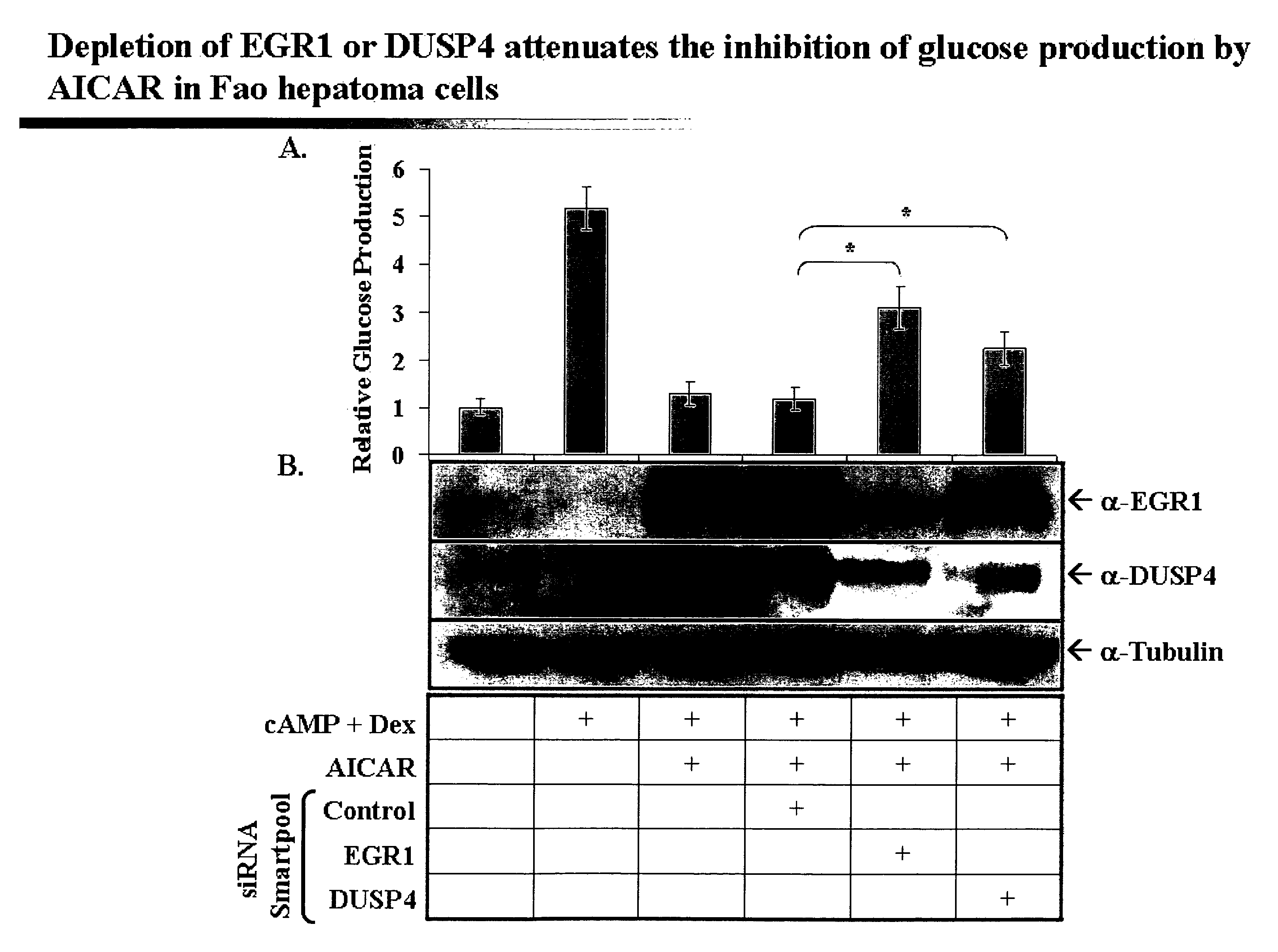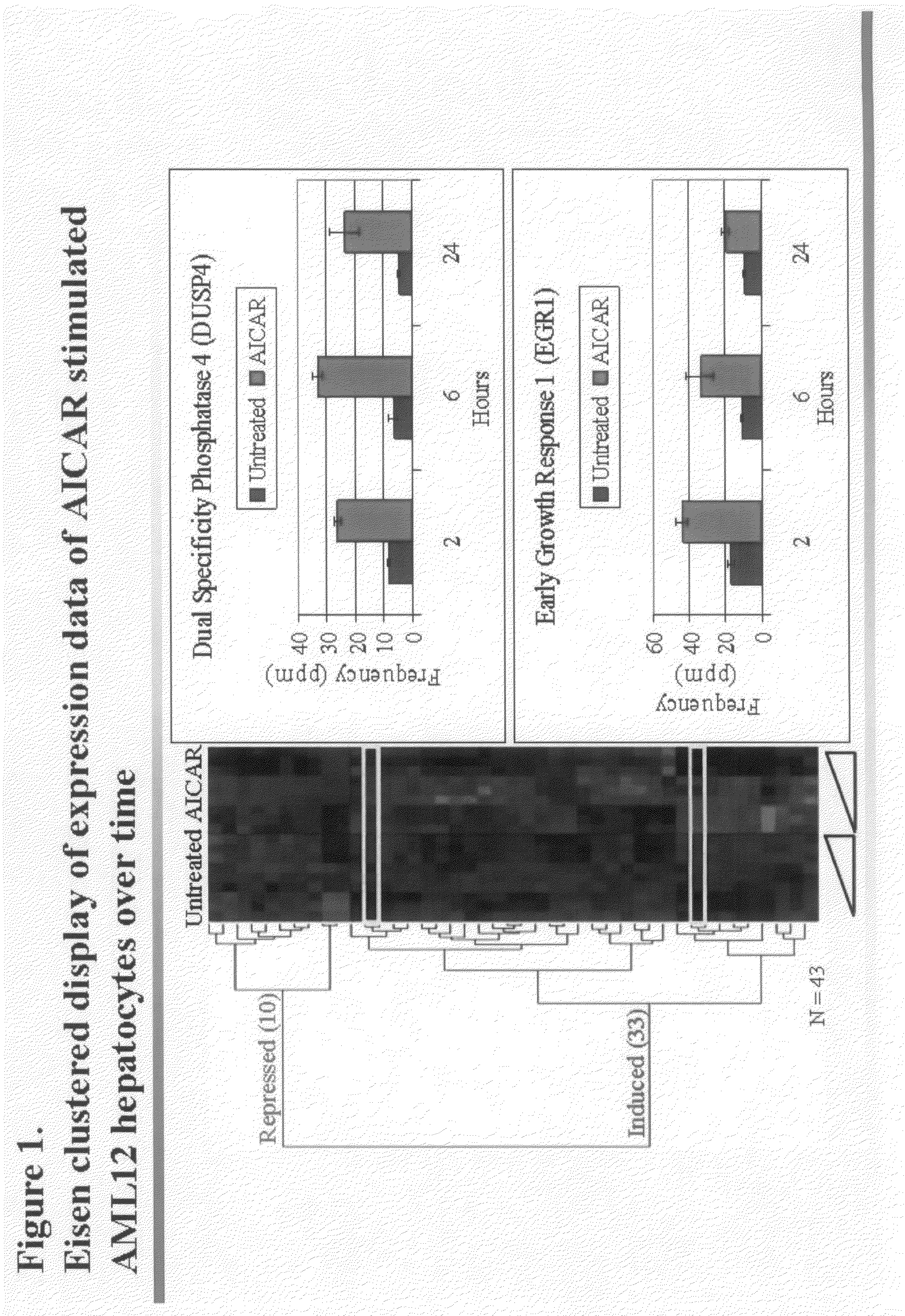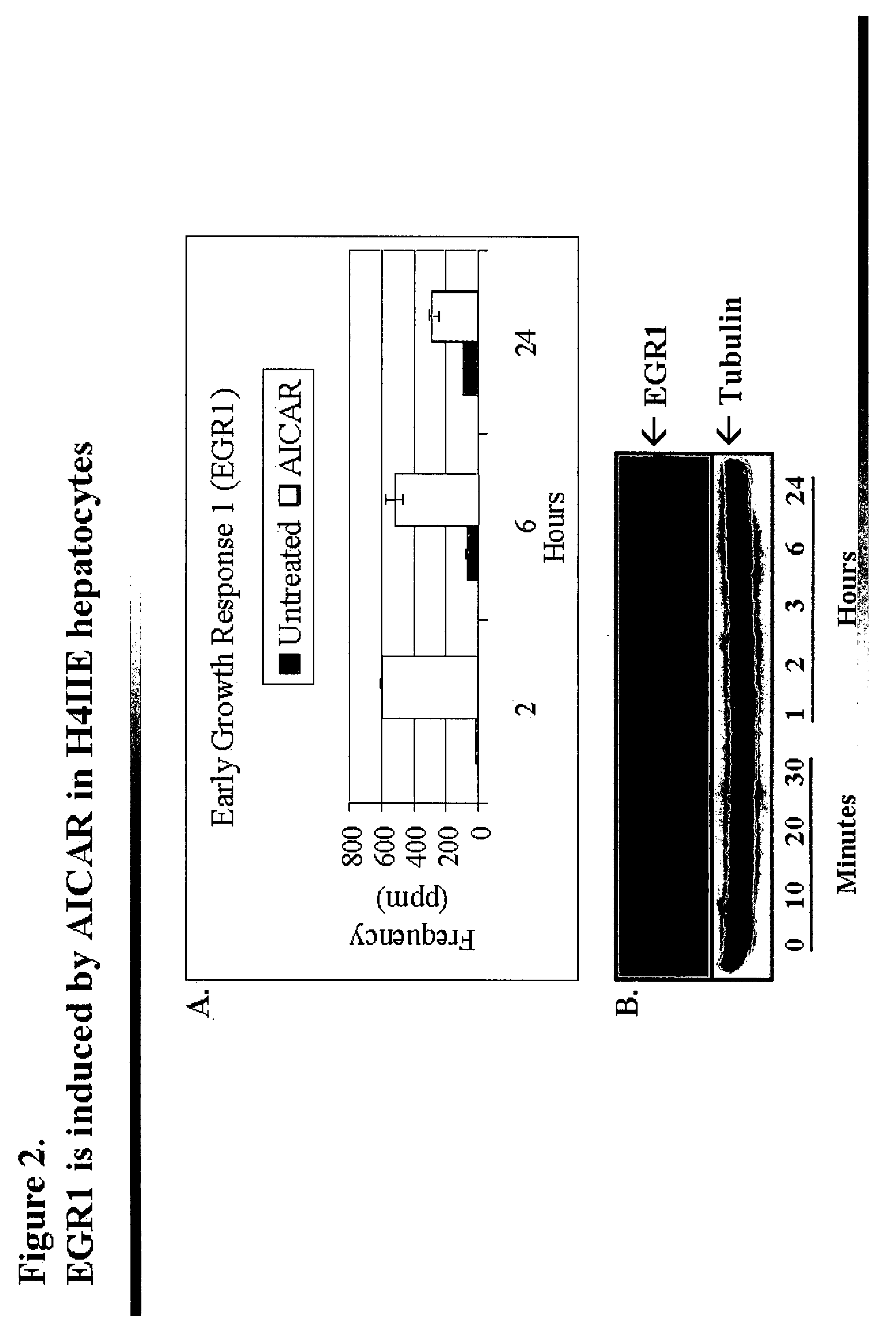Modulators of gluconeogenesis
a gluconeogenesis and module technology, applied in the field of blood glucose control, can solve the problems of type 2 diabetic patients losing this balance, and achieve the effects of reducing the inhibition of glucose production, and increasing dusp4 activity
- Summary
- Abstract
- Description
- Claims
- Application Information
AI Technical Summary
Benefits of technology
Problems solved by technology
Method used
Image
Examples
example 1
Identification of Transcripts Significantly Regulated by AICAR in Hepatocytes
[0055]In order to identify transcriptional targets of activated AMPK in hepatocytes, with a goal of further understanding its role in negatively regulating gluconeogenesis, the mouse hepatoma cell line AML12 was treated with 500 μM AICAR for either 2, 6, or 24 hours in triplicate. AML12 cells were maintained in DMEM / F12 medium containing 10% FCS, 5 mg / ml insulin, 5 mg / ml transferrin, 5 ng / ml selenium and 40 ng / ml dexamethasone.
[0056]Double-stranded cDNA was synthesized starting with 5 μg of total RNA from the cells using the SuperScript System (Invitrogen, Carlsbad, Calif.). The cDNA was purified by filtration through Multiscreen filter plate (Millipore), and transcribed in vitro using T7 RNA polymerase (Epicentre, Madison, Wis.) and biotinylated nucleotides (Perkin-Elmer, Boston, Mass.). Hybridization buffer containing the spike pool reagent was added to each of the fragmented cRNA mixtures and each sample...
example 2
EGR1 and DUSP4 Inhibit Gluconeogenic Gene Transcription
[0067]Activation of AMPK via AICAR inhibits hepatic gluconeogenesis through inhibition of the transcription of the rate limiting enzymes phosphoenolpyruvate carboxykinase (PEPCK) and glucose-6-phosphatase (G6P) (Lochhead et al. (2000) Diabetes 49:896-903). Reporter assays were utilized to determine if EGR1 and DUSP4 are effectors of AICAR mediated inhibition of PEPCK and G6P.
[0068]The rat PEPCK promoter (−548 to +73) was amplified from rat genomic DNA using primers 5′-GCCTCGAGCTCGAGTCCAGCAGACACCTAGTGGG-3′ (SEQ ID NO:8) and 5′-GCAAGCTTAAGCTTTCTCGCCGGATTTCCCCTGTTC-3′ (SEQ ID NO:9) (Xu et al. (2003)) J. Biol. Chem. 278:30187-30192). The human G6P promoter (−1227 to +57) was amplified from human genomic DNA using primers: 5′-GCCTCGAGCTCGAGTGAGCTCAGGAATTCAAGACC-3′ (SEQ ID NO:10) and 5′-GCAAGCTTAAGCTTAGATGTCAGCAGAGCCCTTGC-3′ (SEQ ID NO:11). The promoters were subsequently cloned into XhoI and HindIII sites of pSEAP-BASIC vector (Clont...
example 3
Depletion of DUSP4 and EGR1 Abrogates the Ability of AICAR to Inhibit Glucose Production
[0073]Transfection of Fao hepatoma cells with DUSP4 and EGR1 siRNA Smartpools resulted in a 60 and 70% reduction in their relative basal expression respectively (data not shown) as determined by Taqman. RNA was isolated and purified using RNeasy kits (Qiagen) according to manufacturer's instructions. mRNA levels were measured by TaqMan Real-time quantitative PCR using Assay-on-Demand Taqman reagents (Applied Biosystems). Taqman was performed in an ABI PRISM 7000 Sequence Detection System (PE Applied Biosystems) and the data were analyzed according to the manufacturer's instructions.
[0074]FIG. 6 shows the results of glucose production assays in Fao cells upon reduction of EGR1 and DUSP4 by siRNA Smartpool transfection.
[0075]1 million Fao cells cultured in RPMI1640 with 10% FCS were transfected with siGenome SMARTpool reagents for EGR1 (#M-100247-00), DUSP4 (#M-098966-00), or siCONTROL Non-Targetin...
PUM
| Property | Measurement | Unit |
|---|---|---|
| Tm | aaaaa | aaaaa |
| pH | aaaaa | aaaaa |
| time | aaaaa | aaaaa |
Abstract
Description
Claims
Application Information
 Login to View More
Login to View More - R&D
- Intellectual Property
- Life Sciences
- Materials
- Tech Scout
- Unparalleled Data Quality
- Higher Quality Content
- 60% Fewer Hallucinations
Browse by: Latest US Patents, China's latest patents, Technical Efficacy Thesaurus, Application Domain, Technology Topic, Popular Technical Reports.
© 2025 PatSnap. All rights reserved.Legal|Privacy policy|Modern Slavery Act Transparency Statement|Sitemap|About US| Contact US: help@patsnap.com



